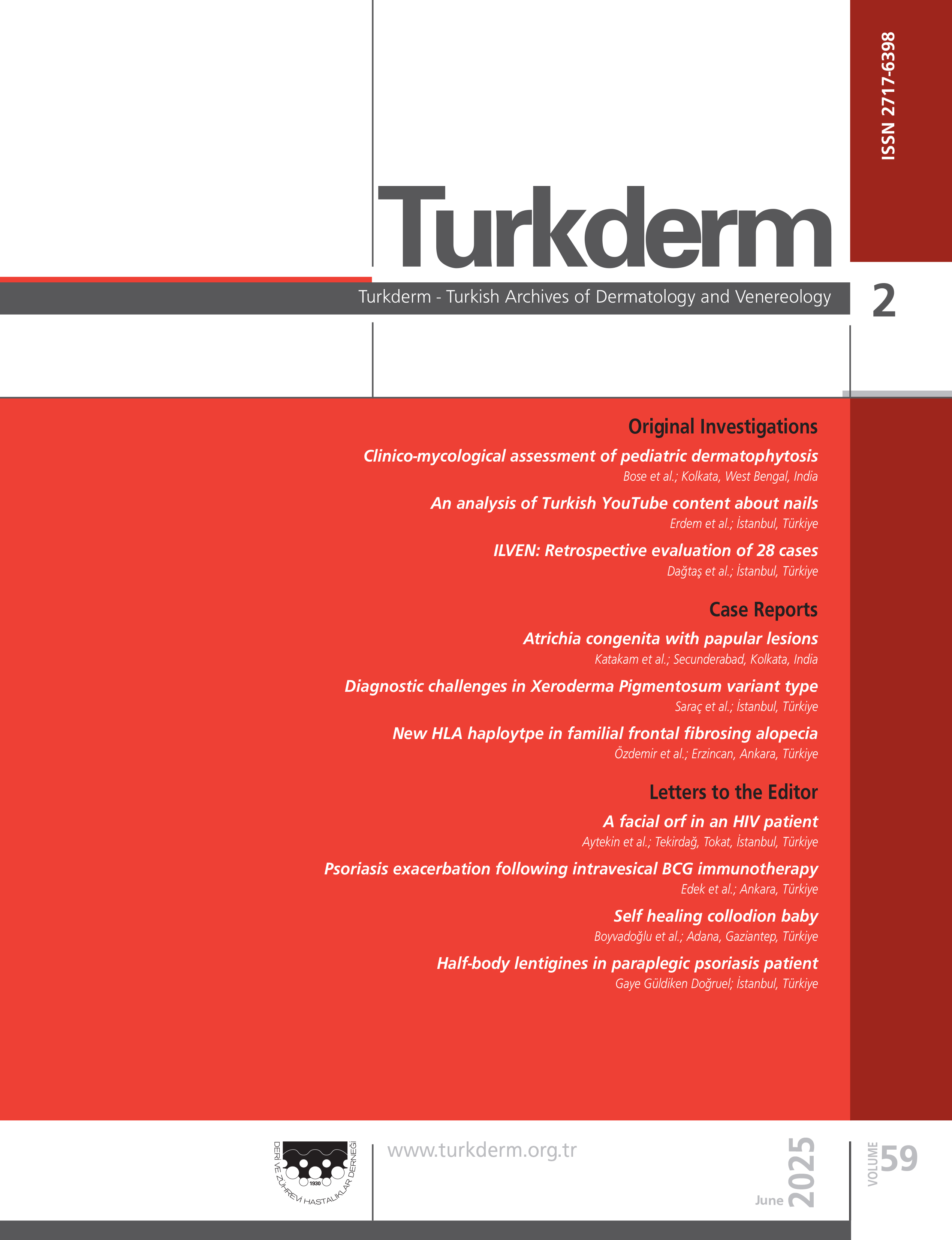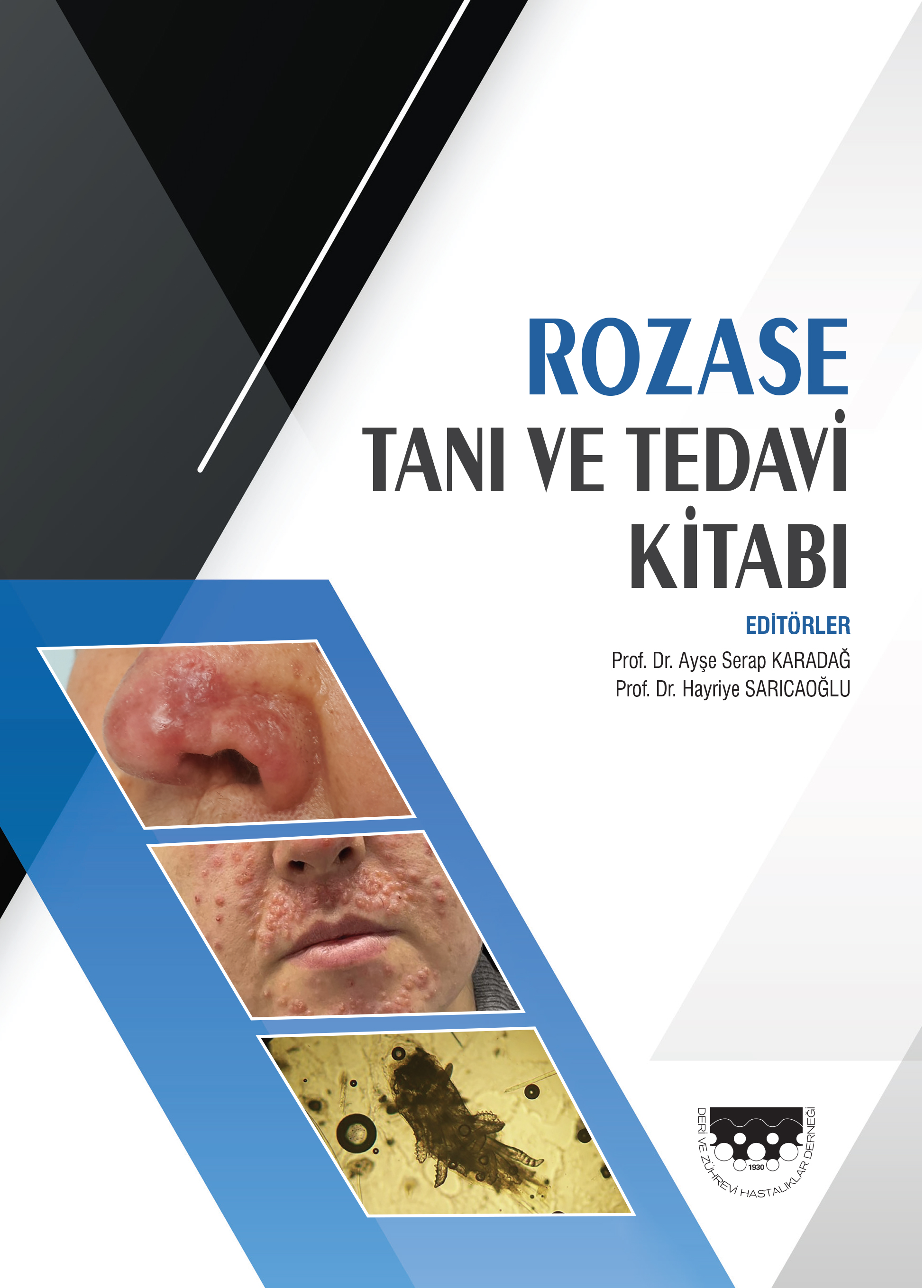Precancerous skin lesions and malignant skin tumors associated with hydroxyurea treatment: Evaluation of a large series and review of the literature
Can Baykal1, Kübra Nursel Bölük1, Sıla Kılıç Sayar2, Şule Öztürk Sarı3, Amid Mahmudov1, Nesimi Büyükbabani31İstanbul University, İstanbul Faculty of Medicine, Department of Dermatology and Venereology, İstanbul, Turkey2Bahçeşehir University Faculty of Medicine, Department of Dermatology and Venereology, İstanbul, Turkey
3İstanbul University, İstanbul Faculty of Medicine, Department of Pathology, İstanbul, Turkey
Background and Design: Malignant skin tumors have been reported in patients using hydroxyurea (HU) for hematological disorders. This study aimed to investigate the characteristics of precancerous skin lesions and malignant skin tumors in association with long-term HU therapy.
Materials and Methods: Records of consecutive patients diagnosed with precancerous and cancerous skin lesions during HU therapy in a single dermatology department between 2008 and 2021 were retrospectively analyzed.
Results: Among 13 patients (mean age: 66.5 years) treated with HU for five different hematological diseases, 11 had used HU >5 years, whereas the time was shorter in the other two patients. The period between HU treatment initiation and the appearance of the first lesion was approximately 9-10 years. Actinic keratosis (AKs) were found in two patients, non-melanoma skin cancers (NMSCs) accompanied by AKs in seven patients, and only NMSCs in four patients. Melanoma was seen in a patient with NMSCs and AKs. In total, 12 basal cell carcinomas (BCCs), 12 squamous cell carcinomas (SCCs), and one melanoma were diagnosed. The superficial type was the most common type of BCCs, followed by the nodular type. NMSCs were located mainly on the face, followed by the scalp, neck, and extensor surfaces of the upper extremities.
Conclusion: The results of this large series support the possibility of the relationship between UV-induced skin cancer and HU therapy. SCCs and BCCs showed equal incidence in the present study in contrast to some previous reports, and different BCC types may occur in these patients. As many patients have more than one malignant skin tumor, protective measures against sunlight, which is another inducing factor for these tumors, and a long-term follow-up, should not be ignored.
Hidroksiüre tedavisi ile ilişkili prekanseröz deri lezyonları ve malign deri tümörleri: Geniş bir serinin değerlendirilmesi ve literatürün gözden geçirilmesi
Can Baykal1, Kübra Nursel Bölük1, Sıla Kılıç Sayar2, Şule Öztürk Sarı3, Amid Mahmudov1, Nesimi Büyükbabani31İstanbul Tıp Fakültesi, Deri ve Zührevi Hastalıklar Anabilim Dalı, İstanbul2Bahçeşehir Üniversitesi Tıp Fakültesi, Deri ve Zührevi Hastalıklar Anabilim Dalı, İstanbul
3İstanbul Tıp Fakültesi, Patoloji Anabilim Dalı, İstanbul
Amaç: Hematolojik hastalıklar için hidroksiüre (HÜ) kullanan hastalarda malign deri tümörü gelişimi daha önce bildirilmiştir. Bu çalışma ile uzun süreli HÜ kullanımı ile ilişkili premalign deri lezyonları ve malign deri tümörlerinin tüm özelliklerinin araştırılması amaçlanmıştır.
Gereç ve Yöntem: Tek bir dermatoloji merkezinde 2008-2021 yılları arasında HÜ tedavisi sırasında prekanseröz deri lezyonu veya malign deri tümörü tanısı alan ardışık hastaların dosyaları retrospektif olarak incelendi.
Bulgular: Beş farklı hematolojik endikasyon için HÜ kullanan 13 hastada (ortalama yaş 66,5 yıl) prekanseröz deri lezyonu [aktinik keratoz (AK)] veya malign deri tümörü görüldü. Hastalardan 11i bu ilacı 5 yıldan uzun süre kullanmışken 2sinde bu süre daha kısaydı. İlk lezyonların oluşumu ile ilacın başlangıç tarihi arasında ortalama 9-10 yıllık bir süre vardı. İki hastada tek başına AK görülürken 7 hastada melanom dışı deri kanseri ve AK beraber görüldü. Dört hastada ise sadece melanom dışı deri kanseri saptandı. Melanom dışı deri kanseri ve AK görülen hastaların birinde ayrıca melanom saptandı. Toplamda 12 bazal hücreli karsinom (BHK), 12 skuamöz hücreli karsinom (SHK) ve 1 adet melanom tanısı konuldu. En sık görülen BHK tipi, yüzeyel tipti ve bunu nodüler tip takip etti. Melanom dışı deri kanserlerinin en sık yerleştiği bölge yüz olup bunu saçlı deri, boyun ve üst ekstremite ekstansör yüzeyleri izledi.
Sonuç: Bu geniş serinin sonuçları, UV ilişkili deri maligniteleri ve HÜ tedavisi ilişkisi olasılığını güçlendirmektedir. Daha önceki bazı yayınlardan farklı olarak SHK ve BHK aynı insidansta görülmüş, BHKnin farklı tiplerine rastlanabileceği saptanmıştır. Birçok hastada birden fazla malign deri tümörü olduğu göz önünde bulundurulduğunda HÜ tedavisi alan tüm hastalarda bu tümörlerin oluşumunu kolaylaştıran diğer bir faktör olan güneş ışığına karşı koruyucu önlemlere uyulmasının sağlanmasının ve uzun dönem takibin ihmal edilmemesinin önemi ortaya çıkmaktadır.
Manuscript Language: English























